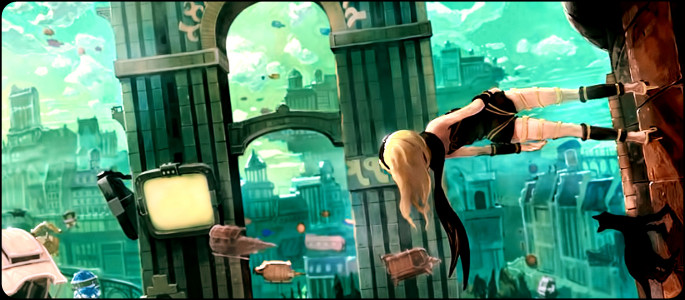My physics professor once said, “Earth’s gravity is a relatively weak force, as far as the universe goes. I fight and defeat gravity every time I walk up the stairs. We fly through the air on planes, hang gliders, and hot air balloons all the time. We laugh at gravity.” If our current aerial transportation modes are the equivalent of laughing at gravity, Gravity Rush on PS Vita is like giving it a huge middle finger, then running over its dog with a truck…while still laughing.
A common misconception about Gravity Rush is that the main character can fly, but rather than flying, leading lady Kat controls the direction in which gravity will pull her. The player will activate her power, aim at gravity’s new origin, and with the touch of a button, send Kat falling in whatever direction that might be. Shel Silverstein would be proud. This unique power is the source of Gravity Rush‘s real strength. Floating, aiming carefully, then choosing the new official direction of gravity as Kat’s main mode of transportation is insanely fun. When a mission calls Kat the entire way across town, the journey there will sometimes be as exciting as the task itself. Not since Jet Grind Radio has simply moving from one place to another been such a joy.
Bright pink gems add another reason for the player to try and see every single spot in the city. These stones function as Kat’s upgrade system; players collect them and level up attributes such as the power of certain attacks, her health, her fall speed, and so on. Collecting these gems is grand fun, thanks to the game’s unique movement style, and deciding how to spend them is rewarding, though grind addicts may be disappointed to realize that each attribute is capped per chapter. Sorry, you won’t be maxing out your gravity tornado the minute after learning it. This isn’t necessarily a drawback, but worth a mention.
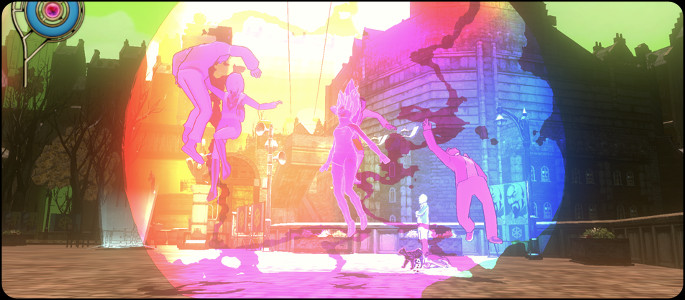
Through the art, character design, direction, and controls, the game does a superb job of making the player actually feel like he is soaring through the air. Having been a game fan for over a quarter of a century, I’ve played plenty of games with flying characters and jumped off my share of high places, but never before have flying and falling come together like this, and never before have they been so fun.
Its introductory stages and missions are constructed perfectly, as Gravity Rush is fun to play while still learning how to play. The player is given simple tasks like “go over there,” which might seem elementary, but in a game this unique, such is a necessary inclusion, to avoid mass frustration. A tutorial that combines learning how to play the game with actually enjoying its features seems hard to come by these days, and Sony Japan Studio deserves credit for pulling this off. After only a chapter or two, most players will have a firm grasp on how to play and how to get the most out of doing so; any time a new ability comes along, it’s taught to Kat in similar fashion. Never did I feel like I didn’t understand a certain ability or other aspect of the game, from beginning to end.
Japan Studio deserves a tip of the hat for the job done on Gravity Rush‘s controls and camera operation. In a game all about falling every possible direction and running around on walls and ceilings, it seems like confusion or disorientation would be part of the package. While it’s not without occasional instances of those feelings, they’re well minimized. The camera always seems to find a good spot, and when it swings around, will give the player a vantage point that makes sense. Kat will jump off a ledge, free fall for several seconds, halt in mid-air, re-launch towards the underside of a balcony, land on it (now walking upside-down), and begin running with smoothness of both control and camera movement that allow the player to keep track of what’s what, the whole time. Whether falling, hovering, fighting, or moving about the city, manual camera operation constantly feels natural, and it’s always easy to see what one need to see. A neat use of Vita tech allows the player to move the machine around and get a look at the surroundings while in mid-air—gimmicky most of the time, but nonetheless cool to show your friends, and it does make itself useful once in a while (although it’s also a good way to look like a tool while riding a bus or train).
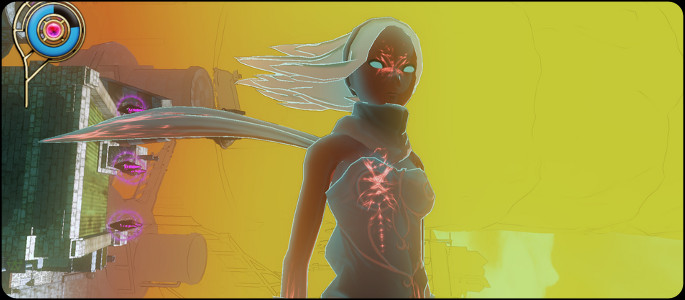
While commendable overall, the controls are not without their quirks and imperfections. When doing one particular slide move, the player needs to turn the Vita not unlike the steering gimmick found in Mario Kart Wii. That might add a dimension of fun, especially on a home console, but it lowers the portability of this portable game, because swinging the system around like that makes you a problem to those you’re sitting next to and a spectacle to those you aren’t. The even bigger sin of control, however, is that dodging is only doable by swiping the screen. In a situation requiring twitch movements like a dodge roll, removal of a thumb from a stick or button and leave the character open in another way or rob the player of another function. On the bright side, one can make it through the game without even using the swipe-dodge.
Every little detail contributes to making the experience unique: the visible wind, the camera movements, the way Kat’s hair flows, the changing position of her rising and falling body, everything. Innumerable games have used shaky cameras, but Gravity Rush uses it to perfection—not too extreme, but it conveys that something is going on, adding just enough of an extra touch to the free falling and smashing into the ground. These tiny bits of attention to detail and feature use-without-abuse is indicative of a dev team really caring about its product. Most players probably won’t even notice these touches, but will definitely feel their effect on the whole package. With all that goes on, Gravity Rush is an entry into the list of games that could be considered art.
Gravity Rush is very brown, especially in the first area; the first district consists mostly of brown, beige, several shades of dark red, occasional deep purple, and a big helping of gray, all of which was actually a favor to the player, since this makes it easier for brightly colored gems, checkpoints, and enemies to stand out. It helps players’ eyes become used to the art of spotting gems while falling at full speed. It’s all part of Gravity Rush‘s friendly learning curve. Later areas get slightly more colorful, though GR maintains its same general look and feel throughout. Don’t take the heavy use of Earth tones as a negative, though, as Rush visually pleasing in practically every way.
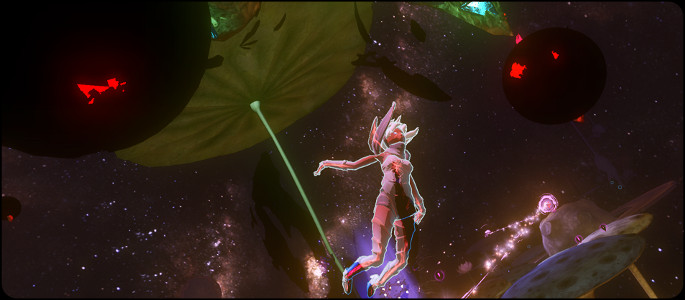
Kat’s adventure will take place mostly in a floating city called Hekseville, more districts of which will open with the passing of time and chapters. One won’t find much interactivity around the city in terms of shops or buildings to go into, and only a handful of NPCs in each section of the town will ever have anything to say, but the much bigger attraction to GR’s exploration is seeing the city itself. Hekseville features impressive, beautiful architecture around every corner; gazing around from any vantage point—land, sky, or the side of a building. There’s so much fun to be had whizzing around the village that one doesn’t need an Elder Scrolls or Yakuza level of interactivity with the townsfolk.
Story is certainly not the reason one plays a game like Gravity Rush, but what’s there is surprisingly interesting. With gameplay this good, this unique, and with this much innovation, Sony could have easily gotten away with phoning this aspect in—”Oh whoa I got these crazy powers by being hit by a shooting star and bitten by a radioactive moon man, now I have to save the world from moon men!” We see that happen in all kinds of games with regularity, and frankly, that’s fine in most cases; yet the story in Gravity Rush actually manages to do a bit more than one might expect…while still of course including a few helpings of moon men. It’s not going to win award for its tale, but it does the base job of an action/adventure/platform game story in providing the character with a reason for doing what she’s doing, then keeping things fresh and somewhat engaging for the game’s duration. This rabbit hole goes deeper than what would generally be expected of this type of game, for the better.
A lot of this tale will be told through digitized manga pages. The player will see mostly still images on the screen with borders around the edges, then advance to the next block of the “page.” Dialogue (most of which is unvoiced) pops up in speech bubbles, making the majority of Gravity Rush‘s story segments like an electronic comic book. I’m not usually a fan of comics, but found the storytelling in Gravity Rush surprisingly enjoyable.
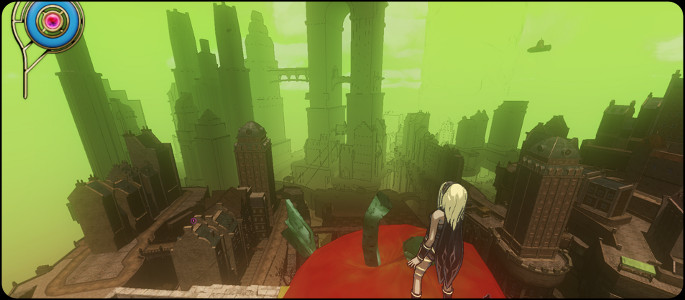
At times, Kat will be called upon to fight off black blobbish enemies, which all have a bright glowing orange weak point that she must strike for massive damage. Enemy types get more varied as the game goes on, and after about the halfway point, there are intense battles to be had. Several of these larger-scale fights take place entirely in mid-air, feeling like their own special brand of dog fight—the constant soaring through the air, turning gravity control on and off in order to stay unpredictable and dodge projectiles, using her attack powers when an opening appears, frantic hunts for health restoration gems, Gravity Rush has some riveting combat. These huge battles that I’ve called “dog fights” don’t happen often, especially in the early going, but when they do, they provide quite a thrill.
Initial combat abilities include of course the basic kick and dodge, though the latter’s required use of the touchscreen makes it often unwieldy. Over time, Kat learns some new powers. Some of these have a target lock-on which is impressively functional. Given that one will be falling every direction and may not even know which way is “up” at times, it’s good to see the enemy lock-on be as forgiving as it is in Gravity Rush. It doesn’t make, for example, Kat’s gravity kick a freaking homing missile with 100% accuracy, but it comes with just enough of an allowance to prevent combat from becoming a headache. There are a few moves in Kat’s repertoire that lack much value in combat, but any player using his head should be able to figure out his priorities.
Gravity Rush has so many strengths, so few weaknesses, and is such a unique title, that it deserves some form of attention from every gamer. The premise and gameplay are so unique that we, as gamers, should reward and encourage this kind of creativity in our industry. It’s not a perfect game, but no game has to be. Playing Gravity Rush delivers sensations that I haven’t felt in years, and it’s truly unrivaled in providing this exact type of fun. Believe the hype. Gravity Rush is a game like no other.
PlayStation LifeStyle’s Final Score
+ Really, shut up, no you haven’t. +/- Neat use of Vita tech, sometimes forced-in or awkward. |
 |
–
